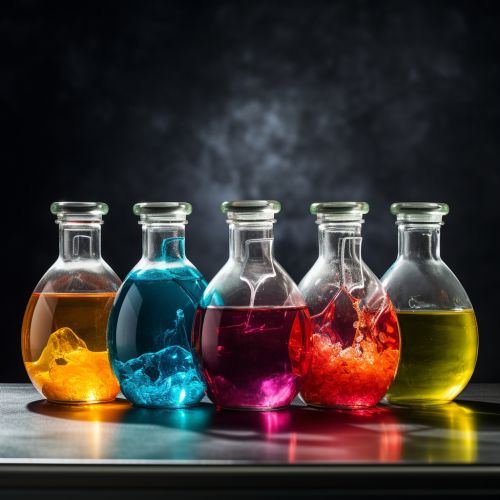Chemistry of color
Introduction
Chemistry of color is a fascinating field that intertwines the principles of chemistry and physics to explain why objects appear the way they do to the human eye. The science behind color involves the interaction of light with matter, specifically the absorption, transmission, or reflection of different wavelengths of light by matter.
Light and Color
Light, a form of electromagnetic radiation, is the source of all color. Visible spectrum is a small part of the electromagnetic spectrum that human eyes can perceive. It ranges from approximately 400 nanometers (violet light) to 700 nanometers (red light). When light interacts with an object, it can be absorbed, transmitted, or reflected. The color we perceive is a result of the wavelengths of light that are reflected or transmitted to our eyes.
Atomic Structure and Energy Levels
The color of an object is determined by its atomic structure. Atoms consist of a nucleus, containing protons and neutrons, surrounded by electrons in specific energy levels or orbitals. These electron configurations determine the energy required to excite an electron from one energy level to another. When a photon of light is absorbed by an atom, it can excite an electron to a higher energy level. When the electron falls back to its original energy level, it emits energy in the form of light. The energy of the emitted light corresponds to a specific color in the visible spectrum.
Color in Chemical Compounds
Chemical compounds often have characteristic colors. This is due to the absorption of specific wavelengths of light by the compound's electrons. The remaining light, which is not absorbed, is either transmitted or reflected, and this is the color we perceive. For example, copper sulfate is a blue compound because it absorbs light in the red region of the spectrum and reflects or transmits light in the blue region.


Color and Chemical Bonding
The type of chemical bonding in a compound can also affect its color. For example, ionic compounds, where electrons are transferred from one atom to another, often produce colors when they are in a crystalline form. This is because the arrangement of ions in the crystal lattice can affect the wavelengths of light that are absorbed, transmitted, or reflected.
Color in Organic Compounds
Organic compounds, which contain carbon atoms, can also exhibit colors. This is often due to the presence of conjugated systems, which are alternating single and double bonds. These systems allow for the delocalization of electrons, which can absorb light in the visible spectrum, resulting in color.
Color in Biological Systems
Color also plays a crucial role in biological systems. For example, chlorophyll, the pigment responsible for the green color of plants, absorbs light in the red and blue regions of the spectrum for photosynthesis. Hemoglobin, the protein in red blood cells, gives blood its red color due to the presence of iron and its interaction with oxygen.
Color Changes in Chemical Reactions
Color changes can often be observed in chemical reactions, indicating that a reaction has taken place. These changes are due to the formation of new chemical compounds with different electron configurations and, therefore, different colors.
Colorimetry and Spectrophotometry
Colorimetry and spectrophotometry are analytical techniques used to measure the concentration of a colored compound in a solution. These techniques are based on the principle of absorbance, which states that the amount of light absorbed by a solution is proportional to the concentration of the absorbing species in the solution.
Conclusion
The chemistry of color is a vast and diverse field, with applications ranging from art and design to biology and medicine. Understanding the principles behind color can provide a deeper appreciation for the world around us and the intricate ways in which light and matter interact.
